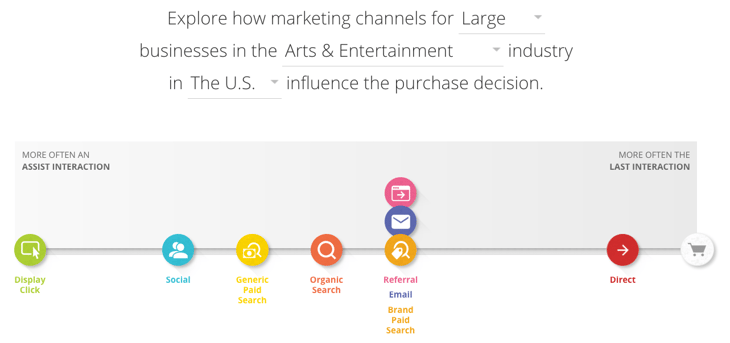Get weekly
HubSpot updates
A common question we’re asked here revolves around proving ROI on social media investment.
I always feel like this is a loaded question. Sometimes I feel like the actual question is: “why isn’t social media driving revenue for my business?” Our response is typically that most business owners, marketing managers, CFOs, MDs, etc. are looking at social the wrong way.
Firstly, social media should not really be perceived as a channel that converts users into customers. Social media is a brand builder — not the sole way to drive business success and revenue growth. Can it drive conversions and increase sales? Absolutely. Is that its primary function? No.
In terms of analogies, my colleague Tristan Minall’s likening of social media to a football team is a pretty good one. Another would perhaps be likening it to certain PR activities, such as press coverage.
Press coverage is clearly an important tactic within a marketer’s or PR’s arsenal. But if you get an interview with your CEO in a local or national newspaper do you expect the phone to start ringing immediately? It’s not likely. Social media needs to be thought of in the same light.
Social media is a long term tactic, and you have to put a lot of hard work and effort in. It’s also not for every business - despite what people may tell you. This is something we preach heavily - you don’t need to be on social media, and you certainly don’t need to be on every channel.
I think as marketers we’re partly to blame for this. We’ve made a rod for our own back by constantly screaming from the rooftops: “you can track digital so much more easily than offline methods!”. This is true, but it does come with the caveat that it’s not a foolproof method of understanding comprehensive ROI on all spend.
How can you prove social media ROI?
Back to the original question however - ‘how can you prove social media ROI?’ In truth, it’s pretty difficult, if not impossible, to track the complete return on investment of this particular medium. Why? Because how do you track the impact of someone seeing your Facebook post, recommending the product or service to a friend, and then their friend visiting your website to buy that product or service.
This isn’t just applicable to social media. One could argue it applies to pretty much every marketing discipline. Anyone that says tracking this activity is easy, is lying. Similarly, anyone that says it can’t be done is also telling a bit of a fib. Honestly, it’s somewhere in the middle of these two statements. Let me explain why.
Google’s tool, The Customer Journey to Online Purchase, explains whether certain marketing channels play more of an assisting role — where they are more geared towards the start of a consumer’s purchase cycle — or a converter — when the channel is often the last interaction before a user converts. It’s worth noting that the data here relates to transactions from 42,000 Google Analytics properties with eCommerce tracking enabled. You can then dissect the data by looking at the size of business, the industry and the country. An example dataset can be seen below:

As you can see, social media appears towards the left hand side for the subset of data — large businesses in the arts and entertainment industry in the U.S.
If you start playing around with the tool, you’ll find that social media is on the left hand side more often than not. Infact, if you break this information down, in the US and UK social media plays more of an assisting rather than converting role 30% of the time.
There are some caveats to this data. Namely, the fact that it only looks at a handful of countries, and only eCommerce transactions. Having said that, we can draw some useful conclusions, principally that social media is there to help other channels convert consumers.
Like I said earlier, that doesn’t mean that it can’t convert users, and it doesn’t mean that it can’t be tracked. It’s just very difficult to track the more intangible benefits, such as brand awareness.
It becomes increasingly difficult when considering organic social posts as the metrics provided by the applicable social channels don’t focus on fiscal statistics. You get an understanding of reach (how many users saw your post) and engagement (how many people are actually interacting with the post). You can also track social media users who visit your site using your web analytics tool - and if you’ve set up conversion tracking, you’ll be able to see which of those visitors have carried out important actions on your site (or even offline). You can even record the success of each individual post if you successfully implement UTM parameters, but nothing that relates to ROI
Click-through and view-through conversions
The problem with this method is that it only works if your users have physically clicked on the link you shared. These are known as click-through conversions which apply to various advertising models and platforms such as Google AdWords, Bing Ads, Facebook Advertising and more. The issue with this is if they’ve seen the site and not clicked the link, but then visited your domain a few days later, your analytics tool will attribute a part of the conversion path to the channel they came to the website from at this later date.
Social advertising,however, gives you an opportunity to start getting closer to the closed-loop analytics you’ve always dreamed of.
This process is known as view-through conversions.
View-through conversions cater for the exact example I’ve described - when someone views your ad, doesn’t engage, but then visits your website at a later date and completes an action that is deemed to be important to you.
The only tools that can give you this view-through conversion data is the advertising platform itself (unless you find a clever way to import their data into your analytics platform, and if you do, please tell me!). It’s a bit outside the depth of this article to explain how exactly to implement the conversion tracking itself, but we have a couple of articles that can help:
- How to set up Twitter Conversion Tracking
- Setting Up Conversion Tracking on Facebook by Jon Loomer
- How to set up LinkedIn Conversion Tracking
There are caveats to this in terms of data tracking. At the time of writing, none of the above platforms cater for any form of IP exclusions to enable you to filter our internal traffic. The only way I can think of doing it is by blocking the pixel from loading onto a website using an IP exclusion on Google Tag Manager (hat tip to Matt Beswick for that idea). At some point, I’ll get round to creating a tutorial for that, but hopefully Simo Ahava’s blog should suffice for now.
Speaking purely in the language of business metrics, to start understanding social media ROI you must have goal or conversion tracking setup on your website, and/or (preferably ‘and’!) some form of advertising running from the social platform of choice that incorporates the use of the respective platform’s tracking pixels. Without this, you’re never even going to get out of the blocks.
But we must not necessarily think about it in this respect. Social media can generate a return on investment, but if you’re looking at fiscal metrics as social media’s primary key performance indicator, chances are you’re barking up the wrong tree. You should be looking at:
- Engagement;
- Reach;
- Shares; and
- Brand mentions.
If these metrics are moving in the right direction, then also turn your attention to:
- Conversions (social media is the last channel before someone submits an enquiry or purchases);
- Assisted conversions (social media was involved in the purchase journey, but was not the last channel before the conversion occurred);
- Click-through conversions; and
- View-through conversions.
If you believe that social media is the one marketing tactic available to increase sales and conversions, then you’re likely to need to change your thinking and start considering other channels like PPC.
Remember — you don’t have to be on social media — nobody logs on to their social accounts and thinks: “that brand hasn’t posted for awhile, I wonder what’s going on.”
Brands are fundamentally interrupting a user’s experience on social, and they’re not logging on to be sold to. That’s why other channels, such as search (either paid of organic) tend to be much more prevalent as ‘convertors’.

